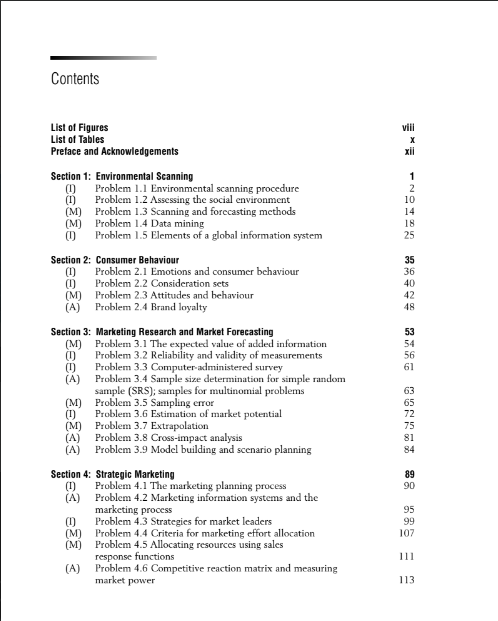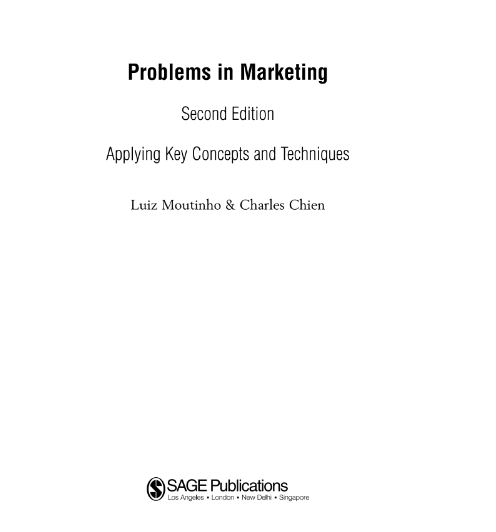


Welcome to the second edition of Problems in Marketing: Applying Key Concepts and Techniques. I am very pleased that I had the good sense of inviting my good friend Dr Charles S. Chien, from Feng Chia University in Taiwan, to co-author this new edition. Apart from being an accomplished researcher and solid academic, his impact to this new edition was invaluable, incisive and of extreme importance. I am therefore very grateful to him. Although there is a time lag since the first edition of this book appeared on the academic market 12 years ago, my special attachment for this book and its innovative features have always remained high and it is one of my favourite textbooks.
The ethos of the book has remained the same – it should be used primarily as a supplementary teaching and learning tool for any major marketing textbook. It can also be used for specialised electives at postgraduate levels and final-year undergraduates. The content of the book is still designed to provide many examples of marketing management practice, with each analytical problem concentrating on particular concepts or techniques. I would like to thank all those adopters of the book who, at the time of its launch, were brave enough to be challenged with the degree of innovative traits provided in the text – its very nature in terms of analytical reasoning, its mostly quantitative content, as well as the computer-aided problems.
Furthermore, I would like to thank all those adopters, reviewers and academic peers who have provided me with feedback over several years, as well as my many MBA students who were exposed to the book. I have taken into account all their suggestions, comments and criticisms. Moreover, I have used their valuable input to redesign this new edition of Problems in Marketing: Applying Key Concepts and Techniques. What are then the new features of this edition? First, there are 72 analytical problems in total, covering 11 key areas of marketing management. This number represents a 20 per cent increase in the total number of analytical problems available to marketing lecturers. Three brand new sections have been added, reflecting the contemporary importance of these topics: Environmental Scanning; Internet Marketing; and Issues and Trends Shaping the Future.
Also, one of the previous sections has been repositioned as ‘Integrated Marketing Communication’ and two of the previous sections have been combined into a new one – ‘Marketing Research and Market Forecasting’. ‘Consumer Behaviour’ has become a stand-alone section and, finally, ‘Positioning’ has been combined with ‘Product Policy Branding and New Product Development’. As a response to a direct request from previous adopters, 60 per cent of all analytical problems included in the book are of a qualitative nature, with the remaining 40 per cent being clearly quantitative.
The make-up of the book with regard to the level of difficulty associated with the solving of the problems is pretty much halved. We now have 30 introductory problems, 24 problems of a medium level of complexity and 18 analytical problems that are applied at a more advanced level. As in the case of the first edition, we have developed ten of the quantitative problems so that they can be used and designed as computer-aided problems, meaning that they can be solved through the use of the software package which accompanies this text.
Overall, this new edition represents almost a new book, since over 70 per cent of the analytical problems included are brand new! The most important purposes behind this book are still valid – to help bring the subject of marketing management to life and to provide students with a new range of challenging situations and examples that will help them ‘digest’ hybrid marketing concepts, techniques and methodologies. This has been achieved by coming ‘mind-stretching’, robust, up-to-date and ‘thought-provoking problems’ which reflect ‘managerial reality’.
This book only became a manageable project with the outstanding cooperation, help and support of Claire Leitch, who did a superb job in typing the manuscript. I would also like to thank my SAGE editors – Rosemary Nixon, Kiren Showman and Delia Martinez Alfonso – for all the encouragement, patience and support provided during the preparation of this text. To all of you who gave us motivation and assistance, please accept our gratitude. We hope that you will continue to find Problems in Marketing a useful learning/ teaching resource. Many improvements can still be made, so we are counting on you to provide us with the necessary feedback, advice and positive criticism so that, jointly we can increase once again the book’s substantiality and usefulness. Thanks once again! Enjoy!
A marketing-oriented firm looks outwards to the environment in which it operates, adapting to take advantage of emerging opportunities and to minimise potential threats. In this section we shall examine the marketing environment, and how to monitor it. In particular, we shall look at some of the major forces acting on companies, such as the economic, social, legal, physical and technological issues which affect corporate activities. The marketing environment consists of the actors and forces that affect a company’s capability to operate effectively in providing products and services to its customers.
It is useful to classify these forces into the micro-environment and the macro-environment. The micro-environment consists of the actors in the firm’s immediate environment that affect its capabilities to operate effectively in its chosen markets. The key actors are suppliers, distributors, customers and competitors. The macro-environment consists of a number of broader forces that affect not only the company but also the other actors in the micro-environment. These can be grouped under economic, social, legal, physical and technological forces.
These shape the character of the opportunities and threats facing a company, and yet are largely uncontrollable. The process of monitoring and analysing the marketing environment of a company is called environmental scanning. Two key decisions that management need to make are what to scan and how to organise the activity. Clearly, in theory every event in the word has the potential to affect a company’s operations but to establish a scanning system which covers every conceivable force would be unmanageable. The first task, then, is to define a feasible range of forces that require monitoring. These are the poten- tially relevant environmental forces that have the most likelihood of affecting future business prospects.
The second prerequisite for an effective scanning system is to design a system which provides a fast response to events that are only partially predictable and emerge as surprises and grow very rapidly. This is essential because of the increasing turbulence of the marketing environment. Ansoff proposes that environmental scanning monitors the company’s environment for signals of the development of strategic issues which can have an influence on company performance.
1 Line management functional managers (e.g. sales, marketing, purchasing) can be required to conduct environmental scanning in addition to their existing duties. This approach can falter because of line management resistance to the imposition of additional duties, and the lack of specialist research and analytical skills required of scanners.
2 Strategic planner environment scanning is made part of the strategic planner’s job. The drawback of this approach is that a head-office planner may not have the depth of understanding of a business unit’s operations to be able to do the job effectively.
3 Separate organisational unit regular and ad hoc scanning is conducted by a separate organisational unit and is responsible for disseminating relevant information to managers. General Electrics use such a system with the unit’s operations funded by the information recipients. The advantage is that there is a dedicated team concentrating their efforts on this important task. The disadvantage is that it is very costly and unlikely to be feasible except for large, profitable companies.


